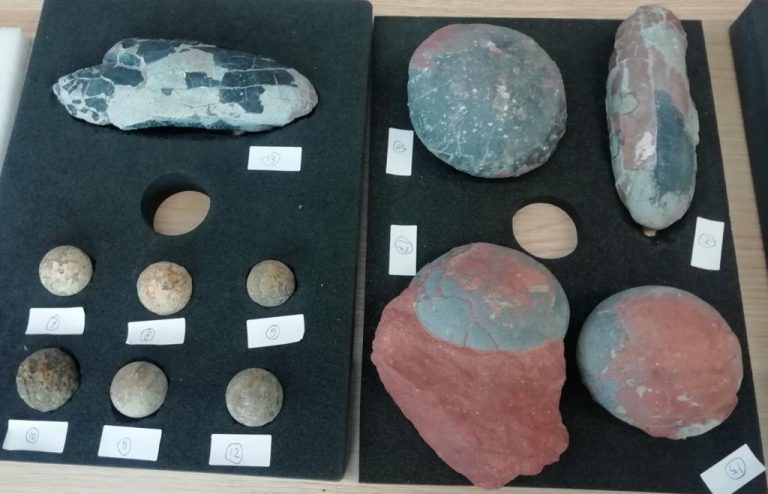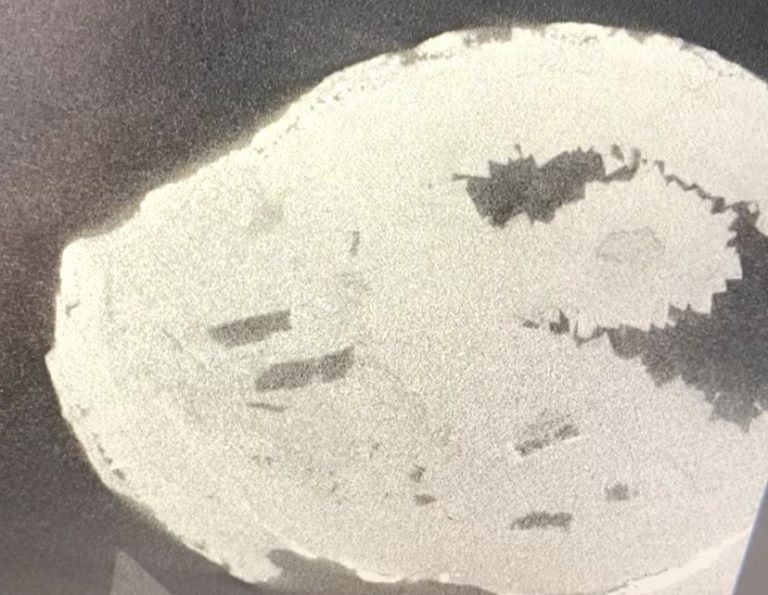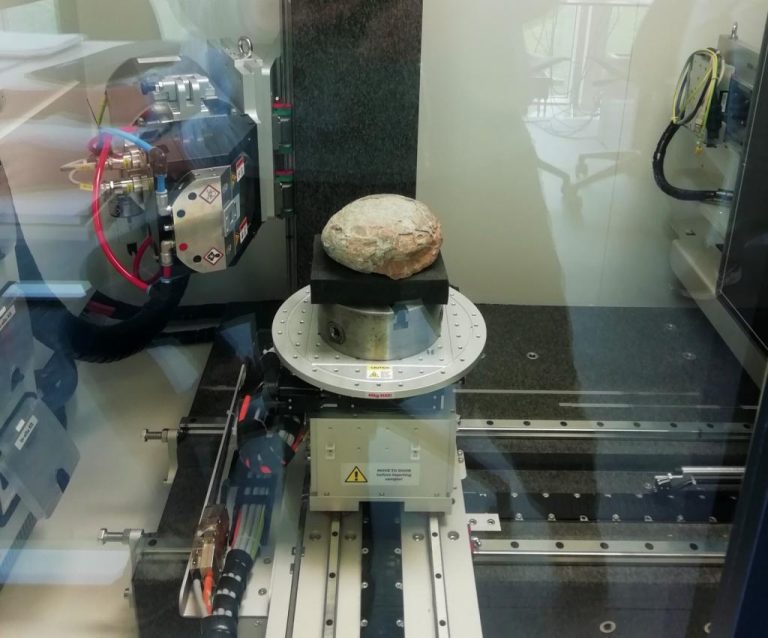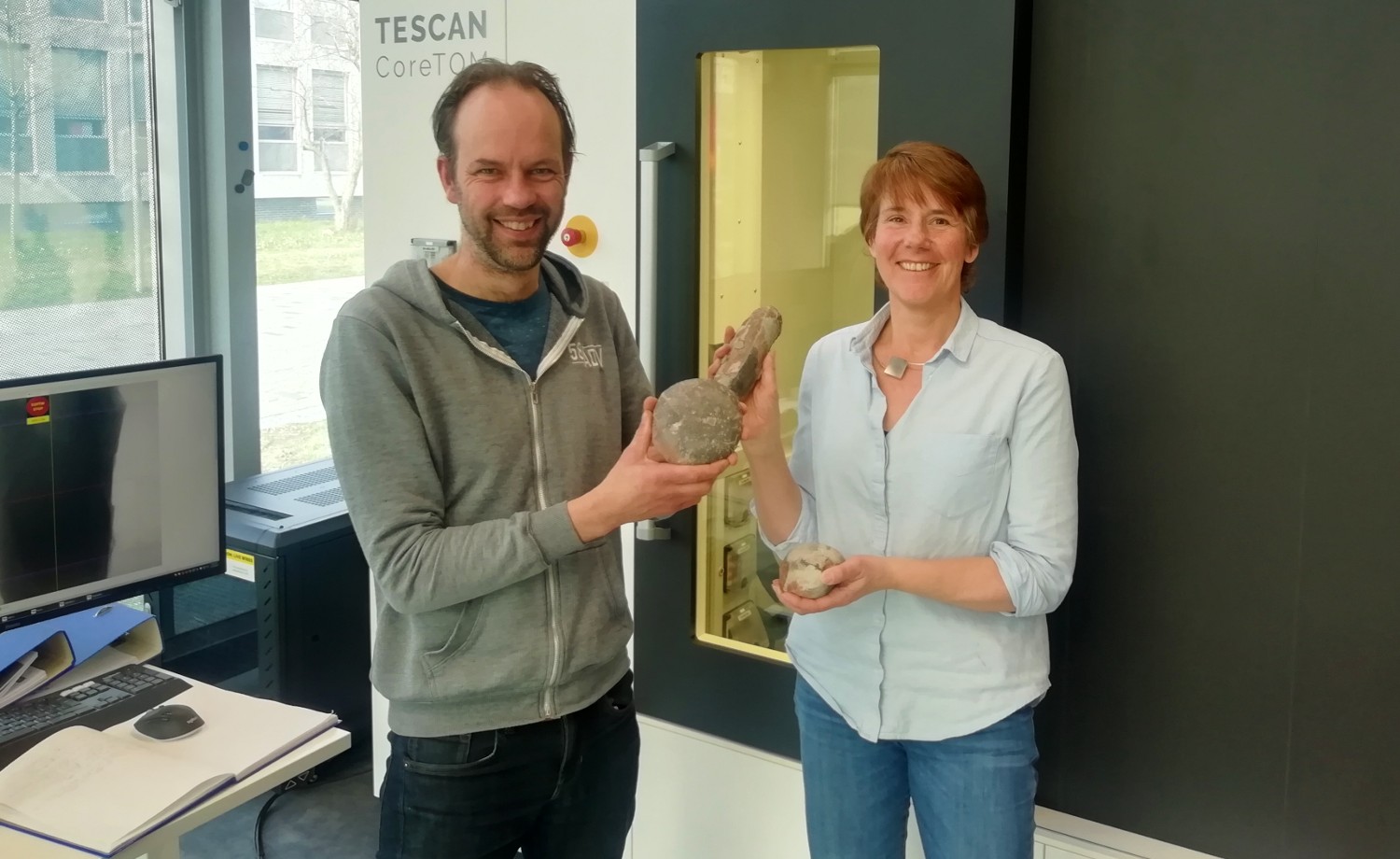Promising dinosaur eggs landed under the micro-CT scanner at CEG in mid-March. The outcome prompted the request for a follow-up study on dinosaur chicks.
Applied Geologist Auke Barnhoorn and CT Technician Ellen Meijvogel-De Koning with some dinosaur eggs from Het Oertijdmuseum's collection. (Photo: private collection Auke Barnhoorn).
“We can do that better,” thought Applied Earth Scientist Dr Auke Barnhoorn (Faculty of Civil Engineering and Geosciences) when he saw the kids’ Jeugdjournaal news programme. It showed two employees of Het Oertijdmuseum (Museum of Prehistory) from Boxtel who had travelled to a hospital with several nests of fossilised dinosaur and turtle eggs to screen the eggs amid great interest. Most of the eggs were still intact, so they may have contained recognisable bones of a dinosaur embryo. Such finds are quite rare and sought after.
The CEG Faculty has micro-CT scanners for the study of rocks. A scan can take up to an hour, but with details smaller than a tenth of a millimetre, the sharpness is unsurpassed compared to scanners found in hospitals. “The scanner was purchased for Earth Science studies,” Barnhoorn explains, “but people contact us with all kinds of samples.” One example was packed clay tablets that the owner wanted to read without having to open them.
‘There’s almost no doubt that there’s a baby dinosaur inside’
Staff at Het Oertijdmuseum saw many white bits on the hospital scan in successive cross sections at the edge of the egg. “There are so many of them that it is almost inevitable that there is a baby dinosaur in there,” said Jonathan Wallaard, senior curator at Het Oertijdmuseum.
Barnhoorn contacted the Museum and offered to screen the most promising eggs at TU Delft with the Faculty’s micro-CT scanner for more detail.

A subset of Het Oertijdmuseum’s collection selected for the CT scan with the smaller turtle eggs on the left and the dinosaur eggs on the right. (Photo: Auke Barnhoorn)
So Junior Curator Maarten de Rijke of Het Oertijdmuseum came to TU Delft on 16 March with a crate of eggs. Fifteen fossilised eggs in total, six of which were from a turtle, a few from an Oviraptor (egg thief) and a Therapoda (carnivorous bipedal dinosaur). The size of the eggs ranged from ‘a sausage roll’ to a honeydew melon.

Screening of a turtle egg showing a profile full of crystals. (Photo: Maarten de Rijke)
Most turtle eggs appeared empty, but one contained a shape that was completely crystallised. De Rijke shot a picture from the screen, but 3D reconstruction has yet to take place.

Dinosaur egg in the CT scanner with the source on the left and the detector on the right. The table rotates 360 degrees during the scan. (Photo: Auke Barnhoorn)
And then there was the large promising dinosaur egg with lots of white pieces. Unfortunately, the micro-CT proved insufficiently powerful to penetrate the surrounding stone layer, so it did not reveal anything more about its contents. The plan now is to remove the surrounding stone layer in the hope that the scanner will then be able to see through it.
The researchers are now working on a joint Epos-NL proposal for the study of 185 fossilised eggs. Epos-NL is the Dutch infrastructure consortium under which the new micro-CT scanner was acquired last year. It gives Dutch earth scientists who have good proposals access to the scanner.
The idea is to use a hospital scanner for a pre-selection and screen ‘the cherry-picked items’ in detail with the slower but sharper TU Delft scanner.
So, pending the response, the dinosaur eggs will remain surprise eggs for now. Happy Easter everyone.
Do you have a question or comment about this article?
j.w.wassink@tudelft.nl


Comments are closed.